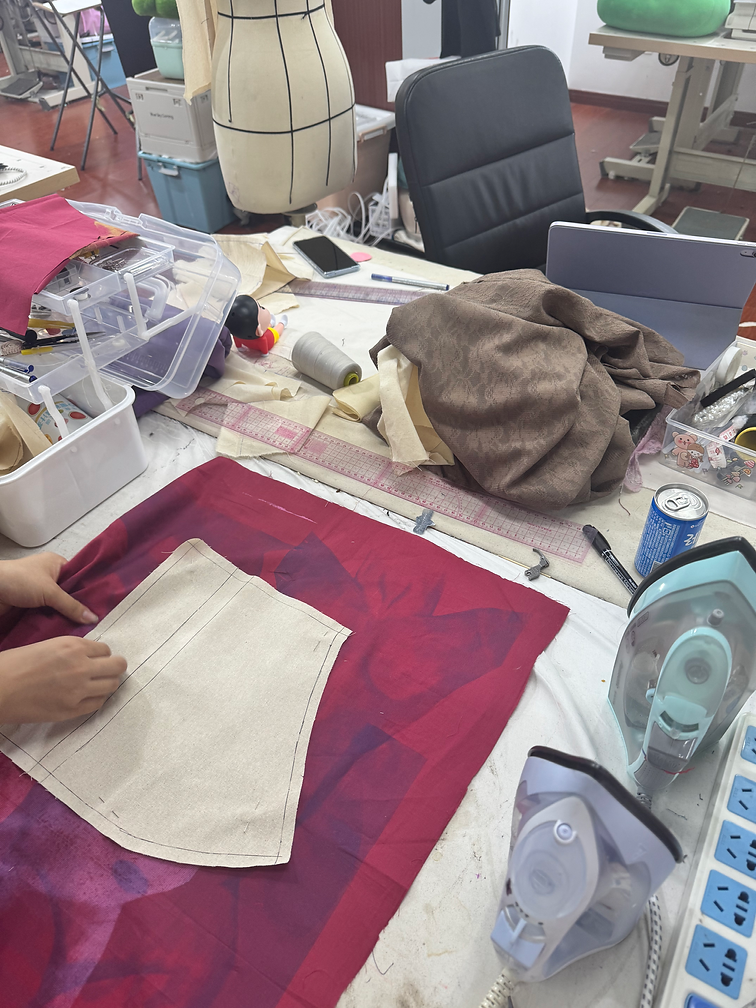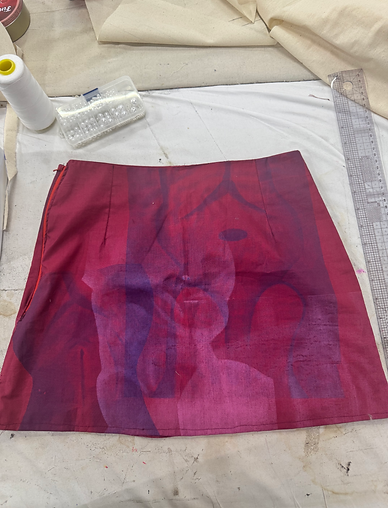Major Project
Collaboration with Shanghai University


Reclaiming the Gaze: Embodying My Art Through Fashion
As part of my MA Fashion Innovation major project, I began by experimenting with wearable art—printing two of my original paintings onto fabric and transforming them into a handmade top. This piece marked a significant turning point in my practice. It wasn't just an aesthetic exploration; it was a conceptual and emotional gesture—translating my abstract depictions of the female body onto garments, turning the body into both canvas and statement. This first top served as a critical bridge between my fine art background and my fashion practice. By choosing to print my paintings—works that challenge traditional beauty standards and celebrate the diversity of women’s bodies—onto clothing, I aimed to quite literally clothe the body in new narratives. This process underscored the importance of self-representation in fashion and allowed me to challenge the mass-produced ideals perpetuated by fast fashion. Making this garment also introduced a new and vital skill: sewing. Up until this point, my work had been two-dimensional. Learning to sew enabled me to shape my art into something tactile, dynamic, and lived-in. The physicality of stitching together a top from my paintings was empowering—it felt like reclaiming authorship over both image and garment. It gave me a deeper appreciation for craftsmanship and the labor behind fashion, which fast fashion often erases.
Where this led my practice
This development paved the way for a transformative experience: a university-led collaboration with Shanghai University. There, I pushed this concept further by printing more of my artwork onto fabric and designing a complete outfit. The process became a full-circle moment—I not only created but also wore my art in a fashion show in Shanghai, embodying the work and walking as a living critique of the narrow standards fashion often imposes. It was a powerful act of reclaiming visibility—not through models, but through my own presence, story, and body. This experience has deepened the core themes of my project: cultural hybridity, female empowerment, and the disruption of traditional gazes in fashion media. It also continues to shape the trajectory of my work as I explore new forms—tapestries, prints, film, and manifestos—that expand this wearable protest into a broader, multidisciplinary campaign for change.
Wearable Art
The first garment I created as part of this project—a simple top printed with two of my abstract paintings—became a pivotal moment in my creative process. Though modest in its form, it was rich in intention. It marked the first time I translated my fine art practice into wearable form. This wasn’t just about producing clothing; it was about allowing my art, which explores themes of the female body, identity, and self-perception, to live and move in the real world.
From Liverpool to Shanghai: Expanding My Vision Through Collaboration
After applying for a university opportunity to collaborate with Shanghai University, I was thrilled to be accepted—this marked the next major phase of my project, where I would take the foundational ideas developed in Liverpool and explore them on an international scale.











Why I created this outfit
I started making additional printed fabrics using my own paintings in the days before the trip. I had previously used one of these digitally printed fabrics to make a skirt back in Liverpool, so I saw the opportunity to create a full ensemble that really embodied my artwork. The project had evolved from a personal experiment into a larger statement on identity, cross-cultural communication, and the potential of wearable art, so while this notion sounded bold, it also felt fitting.
When I arrived in Shanghai, I was matched with a student from Shanghai University to support me during my time there. While we didn’t necessarily form a strong personal connection — likely due to a combination of personality differences, the language barrier, and her naturally spending more time with her fellow classmates — we were still able to work together professionally and respectfully. Despite the communication challenges, she provided vital assistance that allowed me to navigate the university space and bring my ideas to life.
Her help in locating facilities, understanding how to use equipment, and translating instructions or signs was essential. Without her support, I wouldn’t have been able to access what I needed to complete my work efficiently. Though our friendship didn’t develop deeply, our collaboration still sparked important moments of cultural and creative exchange. We discussed design approaches, shared techniques, and reflected on how fashion functions in different cultural and academic contexts — from materials and process to presentation and meaning.
This experience highlighted the realities of working cross-culturally in a creative setting. It pushed me to be more adaptable, patient, and independent, while also gaining a deeper understanding of how collaboration doesn’t always mean connection — but can still be productive and meaningful. It ultimately enriched my project in ways I couldn’t have anticipated.
The finished ensemble, a unified set created solely from my printed paintings, was a perfect example of my idea: to use fashion to represent art, identity, and resistance. It was a moving experience to walk in the final fashion show wearing the clothes I had envisioned, developed, and made (with help from others). It was about walking in my story, where various ethnic cultures came together via creation, and it was no longer simply about fabric and form.
This trip deepened the core principles of my project: the importance of collaboration, the value of hand-making, and the strength of combining personal narrative with wearable expression. The work I created in China affirmed that fashion is not only global—it is a language that can carry meaning, memory, and emotion across borders.








